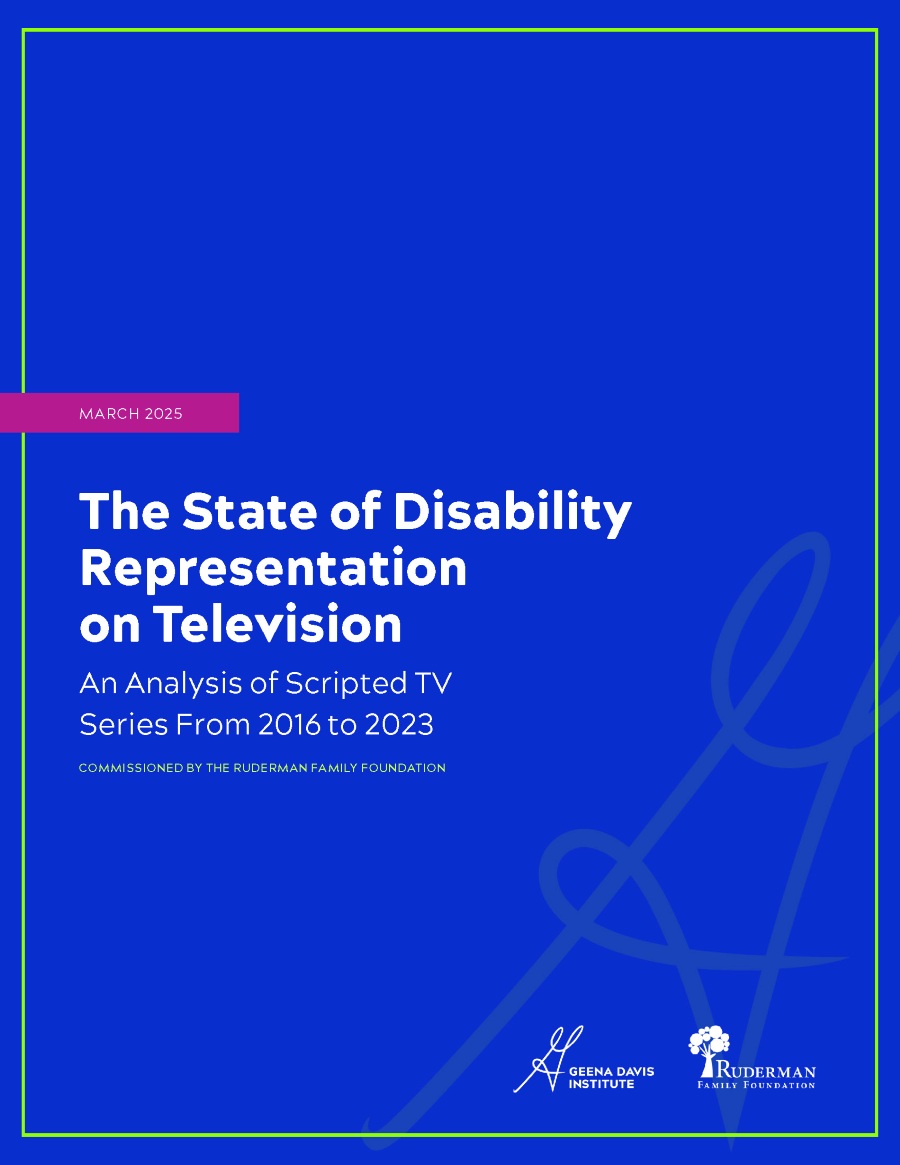
For the full report, you can also visit our partners at the Ruderman Family Foundation here: The State of Disability Representation on Television: An Analysis of Scripted TV Series from 2016-2023.
Commissioned by the Ruderman Family Foundation, we analyzed disability representation in 350 scripted TV series from 2016 to 2023 on streaming/broadcast/cable platforms that originated in the U.S. and were currently in production, according to Luminate Film & TV, by Variety.
Key Findings
- Overall, just 3.9% of characters have a disability. The share of characters with disabilities on TV ranged from a low of 2.6% in 2020 to a high of 4.7% in 2021. Statistical analysis indicates that there is no positive or negative trend in disability representation on screen over the eight years analyzed.
- Overall, among streaming services, 4.7% of characters had a disability, while among broadcast/cable, 3.3% had a disability. The data does not suggest these numbers are improving over the timeframe examined for either platform.
- Overall, 21.0% of characters with a disability were authentically cast by actors with the same (or similar) disability. Statistical analysis indicates that there is no positive or negative trend in authentic casting for disability representation on screen over the years analyzed. However, there was large variance year to year. For example, the lowest share of authentically cast characters with a disability was 8.1% in 2018. The highest share of authentically cast characters with disabilities was 31.8% in 2016.
- Overall, white characters are about one-and-a-half times as likely to be portrayed as having a disability than characters of color (4.4% of all white characters compared with 3.1% of all characters of color). The year of production is not a significant predictor, meaning that the racial diversity of disabled characters is largely stable over the timeframe examined.
- LGBTQIA+ characters were about twice as likely to be depicted as having a disability than those who are not LGBTQIA+ (8.5% of LGBTQIA+ characters compared with 3.7% of non-LGBTQIA+ characters). The year of production is not a significant predictor, meaning that disabled representation among LGBTQIA+ characters is largely stable over the timeframe examined.
- The study finds 56.9% of characters with a disability who are 20 and older shown working or known to have a job, compared with 67.8% of characters without a disability who are 20 and older. In short, characters over 20 with a disability are less likely to be shown working than characters over 20 without a disability.
Recommendations
- Greenlight more stories performed by people with disabilities. Support projects that are from the perspective of people with disabilities and provide the resources to bring these projects to life to increase authentic disability representation on screen. This will also help foster an industry culture that seeks out and values the contribution of people with disabilities.
- Adopt authentic casting practices. Authentic casting will lead to more accurate portrayals in the media. By casting actors with disabilities to play characters with disabilities, productions will be less likely to unconsciously invoke disability tropes and stereotypes. Authentic casting will foster a more inclusive industry and these stories will resonate more deeply with all audiences.
- Be conscientious of intersecting identities when writing and casting characters with disabilities. The study found that most characters represented with a disability were white, and much less racially diverse than nondisabled characters. Consider various identities such as race, gender, and age when casting disabled actors. Also, write the character in a way that shows how the intersection of disability and other marginalized identities leads to a unique experience.
- Write narratives that do not center on a character’s disability. Narratives that integrate disability as one aspect of a character’s identity, rather than the sole focus of their identity, will lead to more accurate portrayals. This approach promotes acceptance of disability and can contribute to a reimagination of disability and its meaning.
- In narratives, reject the presumption that disability means different. Challenge the idea that disability is abnormal; recognize disability as one intersecting identity among many.
- Make accessibility common, and unremarkable on screen. Make sets accessible for those with and without apparent disabilities. Adopt inclusive design by integrating accommodations into the backdrop of the story, such as ramps, assistive technologies, or signs with braille. Equally important is ensuring that the production environment itself embraces accessibility, enabling people with disabilities to fully participate behind the scenes
- Highlight the realities of living with disabilities in storytelling. Accurate representation requires depicting the everyday experiences and accommodations that are important for people with disabilities. For example, narratives involving deaf or hard-of-hearing characters should authentically include interpreters when appropriate, reflecting their role in facilitating communication. This approach not only enhances authenticity but also fosters audience understanding of the diverse realities of disability. By accurately showing such details, stories can contribute to more inclusive and impactful portrayals.
- Show those with disabilities in community with one another. Research shows that when individuals with disabilities are in community with one another, they have better mental health. It is essential that media representations showcase the positive benefits of shared community and community engagement for those with disabilities.
- Avoid ableist language. Ableist phrases and language contribute to the devaluing of those with disabilities. It also presumes able-bodiedness is the norm. It is harmful to make ableist language commonplace as it perpetuates negative attitudes and marginalizes those with disabilities. When scripts include words like “crazy” or “lame,” consider alternatives that describe what is meant, without debasing the disabled community.
Suggested citation:
Conroy, M., Espinoza, C., & Romero Walker, A. (2024). The State of Disability Representation on Television: An Analysis of Scripted TV Series From 2016 to 2023. Ruderman Family Foundation and The Geena Davis Institute. https://rudermanfoundation.org/white_papers/the-state-of-disability-representation-on-television-an-analysis-of-scripted-tv-series-from-2016-2023/.
For more research on the state of disability representation in television, see the “Disability” sections of our annual See Jane TV reports:
- See Jane 2024: How Has On-Screen Representation in Children’s Television Changed from 2018 to 2023? (2024)
- See Jane 2023: How Has On-Screen Representation in Children’s Television Changed from 2018 to 2022? (2023)
- See Jane 2022 TV – See It, Be It: What Children Are Seeing on TV (2022)
- See Jane 2021 TV: The State of Representation in Popular Television from 2016 to 2020 (2021)
- See Jane 2020 TV: Historic Screen & Speaking Time for Female Characters (2020)
- See Jane 2019 An Analysis of Representations in Film and Television (2019)
